In botany, a Fruit is a part of a flowering plant that derives from specific tissues of the flower, one or more ovaries, and in some cases accessory tissues. Fruits are the means by which these plants disseminate seeds. Many of them that bear edible fruits, in particular, have propagated with the movements of humans and animals in a symbiotic relationship as a means for seed dispersal and nutrition.
In many parts of the world, humans and animals have become dependent on fruits as a source of food. In this post, we celebrate the plants and trees, that the fruits many of us know and love, come from. Hopefully there’s a few that you haven’t seen before.
Banana Plant کیلا
Banana is the common name for monocarpic flowering plants of the genus Musa. They are some of the oldest cultivated plants and are grown in at least 107 countries. In popular culture and commerce, “banana” usually refers to soft, sweet, dessert bananas. By contrast, Musa cultivars with firmer, starchier fruit are called plantains or “cooking bananas”. The distinction is purely arbitrary.
Pineapple Plant انناس

The Pineapple (Ananas comosus), named for its resemblance to the pine cone, is a tropical plant with edible multiple fruit consisting of coalesced berries. Pineapples may be cultivated from a crown cutting of the fruit, possibly flowering in 20–24 months and fruiting in the following six months. Raw pineapple is an excellent source of manganese (76% Daily Value (DV) in a one US cup serving) and vitamin C (131% DV per cup serving).
Olive Tree زیتون

The olive is a species of small tree in the family Oleaceae, native to the coastal areas of the eastern Mediterranean Basin as well as northern Iraq, and northern Iran at the south of the Caspian Sea. Its fruit, also called the olive, is of major agricultural importance in the Mediterranean region as the source of olive oil. The tree and its fruit give its name to the plant family, which also includes species such as lilacs, jasmine, forsythia and the true ash trees.
Avocado Tree


The avocado (Persea americana)(botanically a large berry that contains a single seed) is a tree native to Central Mexico, classified in the flowering plant family Lauraceae along with cinnamon, camphor and bay laurel. Avocado or alligator pear also refers to the fruit of the tree. Avocados are cultivated in tropical and Mediterranean climates throughout the world. Trees are partially self-pollinating and often are propagated through grafting to maintain a predictable quality and quantity of the fruit.
Durian Tree کھٹل
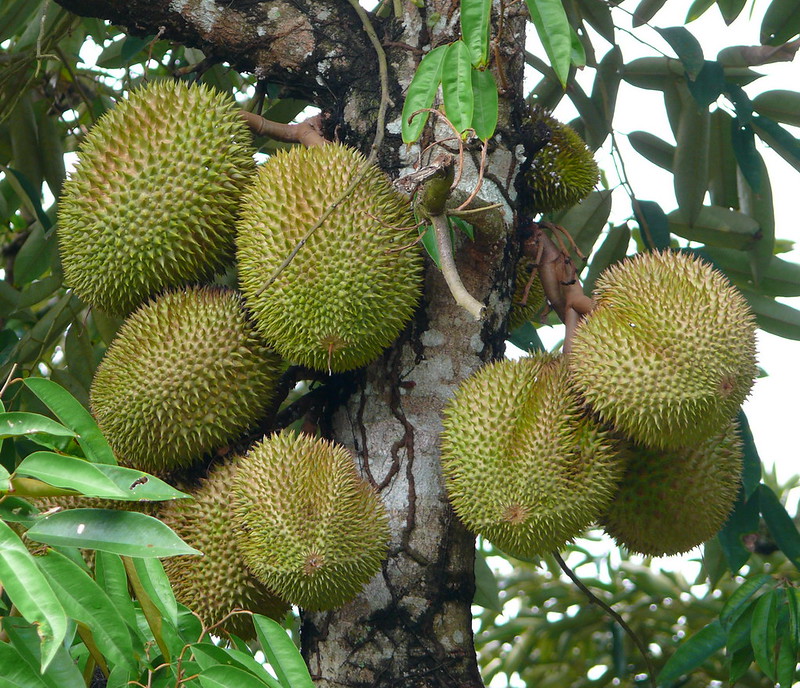
The Durian is the fruit of several tree species belonging to the genus Durio and the Malvaceae family. Regarded by many people in Southeast Asia as the “king of fruits”, the Durian is distinctive for its large size, strong odour and formidable thorn-covered husk. The fruit can grow as large as 30 centimetres (12 in) long and 15 centimetres (6 in) in diameter, and it typically weighs one to three kilograms (2 to 7 lb).
Durian trees are large, growing to 25–50 metres (80–164 ft) in height depending on the species. A Durian falling on a person’s head can cause serious injuries because it is heavy, armed with sharp thorns, and can fall from a significant height. Wearing a hard hat is recommended when collecting the fruit. The odour has led to the fruit’s banishment from certain hotels and public transportation in Southeast Asia.
Watermelon Plant تربوز

Watermelon (Citrullus lanatus, family Cucurbitaceae) is a vine-like (scrambler and trailer) flowering plant originally from southern Africa. Its fruit, which is also called watermelon, is a special kind referred to by botanists as a pepo, a berry which has a thick rind (exocarp) and fleshy centre (mesocarp and endocarp). The watermelon fruit, loosely considered a type of melon – although not in the genus Cucumis – has a smooth exterior rind (green, yellow and sometimes white) and a juicy, sweet interior flesh. A watermelon contains about 6% sugar and 92% water by weight
The Mango Tree اٌم
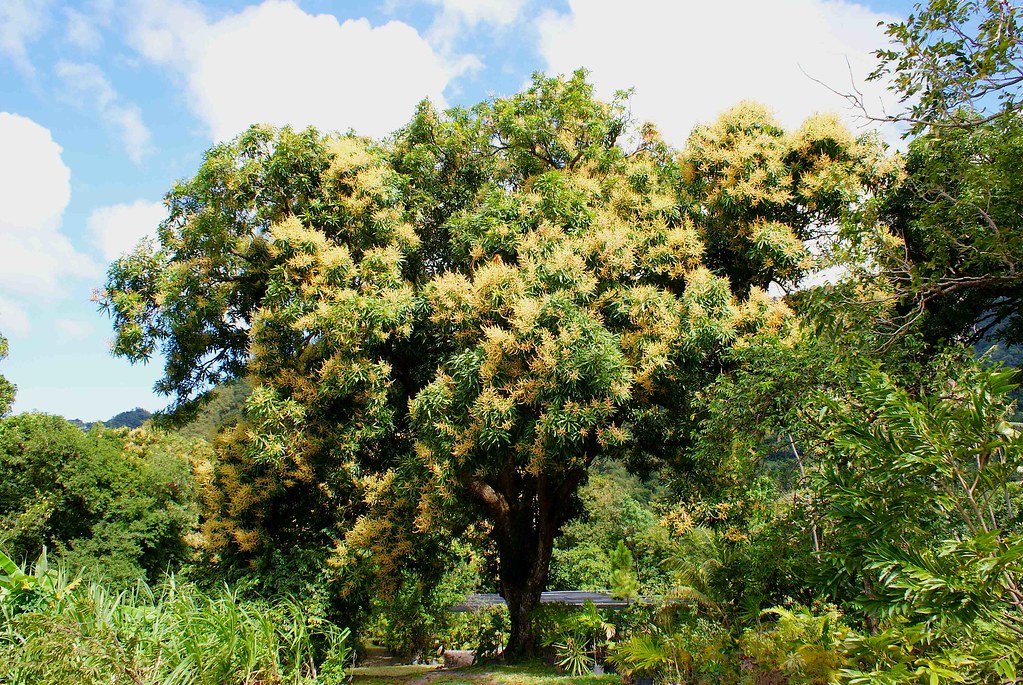
The mango is a fleshy stone fruit belonging to the genus Mangifera, consisting of numerous tropical fruiting trees in the flowering plant family Anacardiaceae. The mango is native to the South Asia from where it was distributed worldwide to become one of the most cultivated fruits in the tropics. Mangifera indica – the ‘common mango’ or ‘Indian mango’ – is the only mango tree commonly cultivated in many tropical and subtropical regions. It is the national fruit of India, Philippines, and Pakistan.
The Date Palm کھجور

The date palm (Phoenix dactylifera) is a palm cultivated for its edible sweet fruit. Although its place of origin is unknown because of long cultivation, it probably originated from lands around Iraq. It grows 70–75 feet in height, growing singly or forming a clump with several stems from a single root system. The leaves are 4–6 m long, with spines on the petiole, and pinnate, with about 150 leaflets; the leaflets are 30 cm long and 2 cm wide. The full span of the crown ranges from 6 to 10 m. Dates contain 20-70 calories each, depending on size and species.
Pine Nut Tree چلغوزہ

Pine nuts are the edible seeds of pines (family Pinaceae, genus Pinus). About 20 species of pine produce seeds large enough to be worth harvesting; in other pines the seeds are also edible, but are too small to be of great value as a human food. In Asia two species are widely harvested, Korean Pine (Pinus koraiensis) in Northeast Asia (the most important species in international trade), and Chilgoza Pine (Pinus gerardiana).
Cone
Cantaloupe Plant خربوزہ
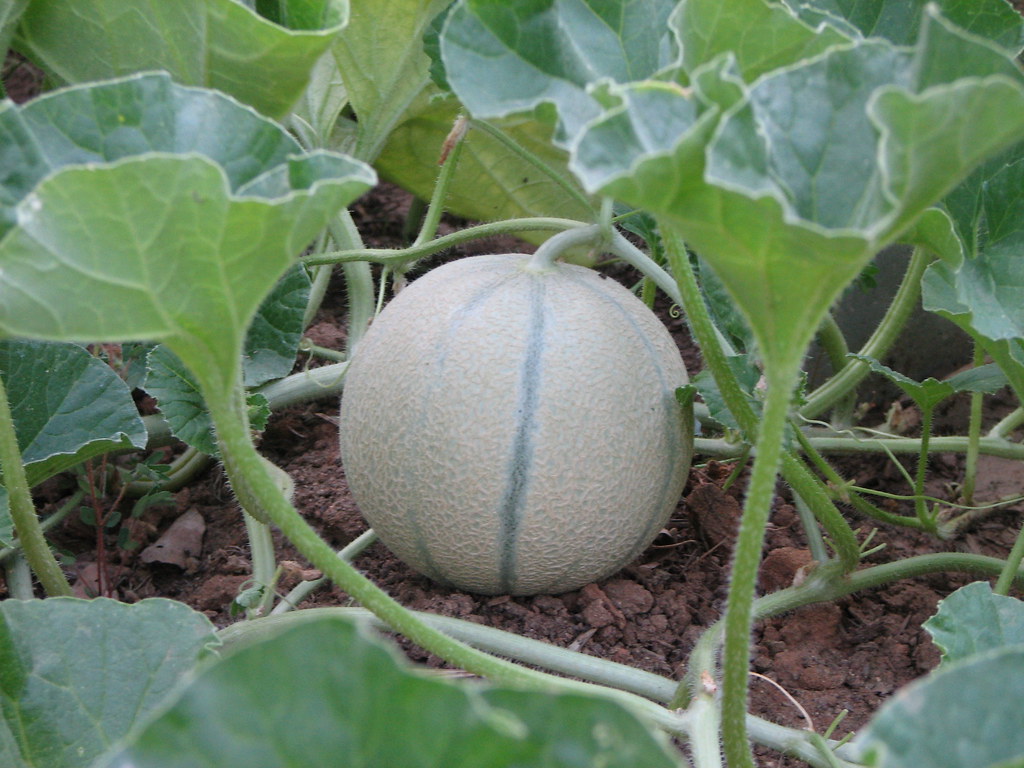
Cantaloupe (also canteloupe, cantaloup, mushmelon, muskmelon, rockmelon, sweet melon, and Persian melon) refers to a variety of Cucumis melo, a species in the family Cucurbitaceae. Cantaloupes range in size from 500 g to 5 kg (1 to 10 lb). It is the most popular variety of melon in the United States.
Papaya Tree پپیتہ
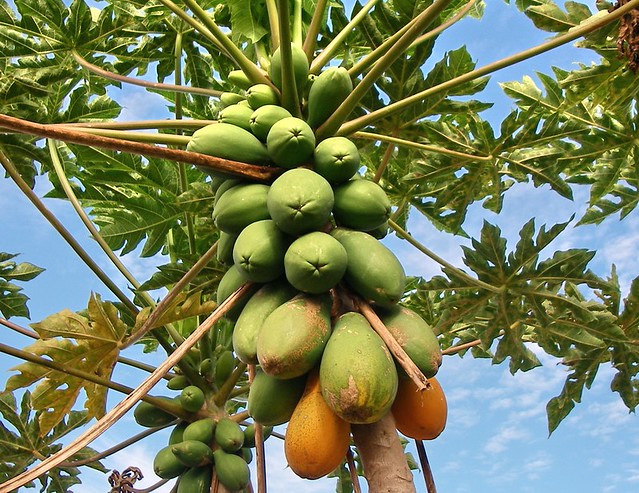
The papaya is a large, tree-like plant, with a single stem growing from 5 to 10 m (16 to 33 ft) tall, with spirally arranged leaves confined to the top of the trunk. The lower trunk is conspicuously scarred where leaves and fruit were borne. The leaves are large, 50–70 cm (20–28 in) in diameter, deeply palmately lobed, with seven lobes. The tree is usually unbranched, unless lopped. The flowers are similar in shape to the flowers of the Plumeria, but are much smaller and wax-like. They appear on the axils of the leaves, maturing into large fruit – 15–45 cm (5.9–18 in) long and 10–30 cm (3.9–12 in) in diameter. The fruit is ripe when it feels soft (as soft as a ripe avocado or a bit softer) and its skin has attained an amber to orange hue.
Plum Tree اٌلوچا
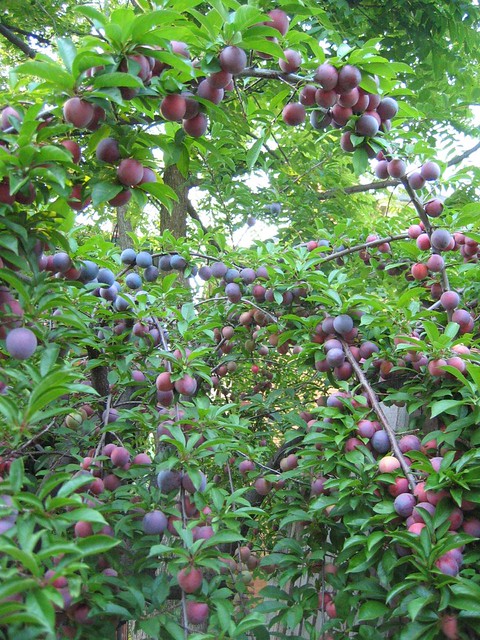
A plum is a drupe fruit of the genus Prunus. The subgenus is distinguished from other subgenera (peaches, cherries, bird cherries, etc. ) in the shoots having a terminal bud and solitary side buds (not clustered), the flowers in groups of one to five together on short stems, and the fruit having a groove running down one side and a smooth stone (or pit). The commercially important plum trees are medium sized, usually pruned to 5-6 meters height. The tree is of medium hardiness. Without pruning, the trees can reach 12 meters in height and spread across 10 meters.
Grapefruit Tree چکوترہ
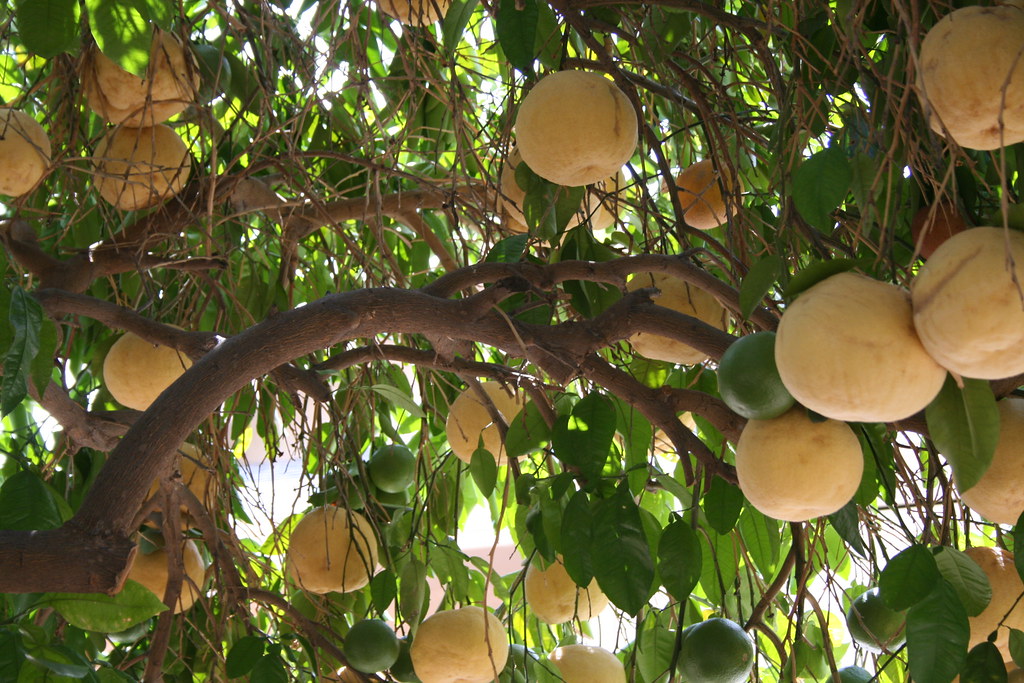
The grapefruit is a subtropical citrus tree known for its bitter fruit, an 18 th century hybrid first bred in Barbados. When found, it was named the “forbidden fruit”. These evergreen trees usually grow to around 5–6 meters (16–20 ft) tall, although they can reach 13–15 meters (43–49 ft). The leaves are dark green, long (up to 150 mm, 6 inches) and thin. It produces 5 cm (2 in) white four-petalled flowers. The fruit is yellow-orange skinned and largely an oblate spheroid; it ranges in diameter from 10–15 cm. The flesh is segmented and acidic, varying in colour depending on the cultivars, which include white, pink and red pulps of varying sweetness. The 1929 US Ruby Red (of the Red blush variety) has the first grapefruit patent.
Pomegranate Tree انار
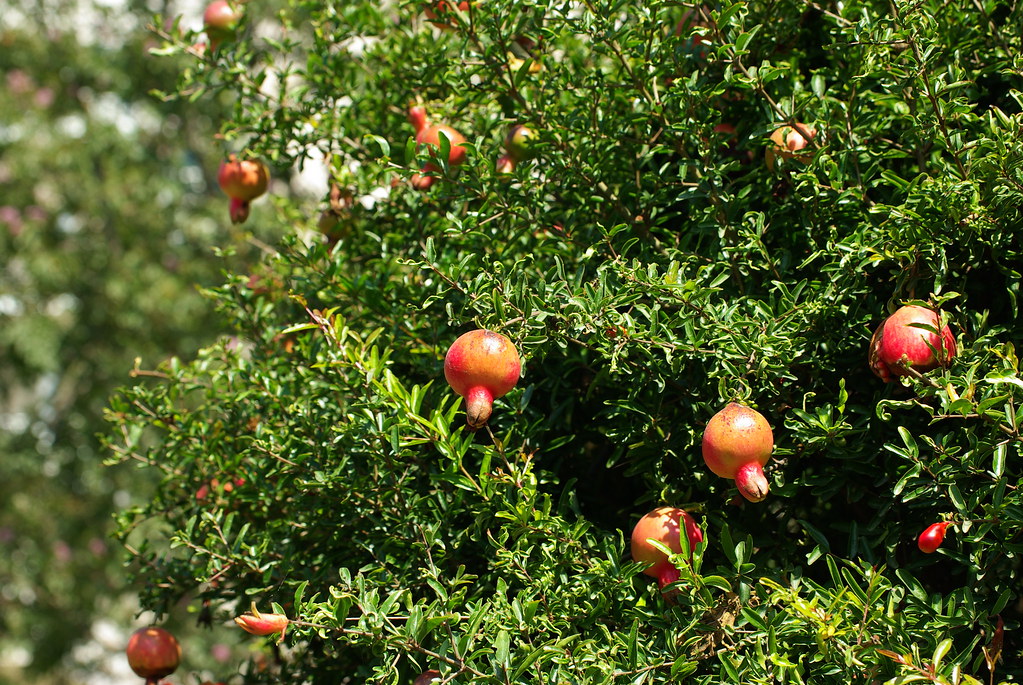
The pomegranate is a fruit-bearing deciduous shrub or small tree growing between five and eight meters tall. Native to the area of modern day Iran and Iraq, the pomegranate has been cultivated in the Caucasus since ancient times. From there it spread to Asian areas such as the Caucasus as well as the Himalayas in Northern India. Today, it is widely cultivated throughout the Mediterranean region of southern Europe, the Middle East, northern Africa and tropical Africa, Indian subcontinent and the drier parts of Southeast Asia. Introduced into Latin America and California by Spanish settlers in 1769, pomegranate is also cultivated in parts of California and Arizona.
Coconut Tree ناریل

The coconut palm, Cocos nucifera, is a member of the family Arecaceae (palm family). It is the only accepted species in the genus Cocos. The term coconut can refer to the entire coconut palm, the seed, or the fruit, which, botanically, is a drupe, not a nut. Found throughout the tropic and sub tropic area, the coconut is known for its great versatility as seen in the many domestic, commercial, and industrial uses of its different parts. Coconuts are part of the daily diet of many people. Coconuts are different from any other fruits because they contain a large quantity of “water” and when immature they may be harvested for drinking.
Posted by Zaffar Iqbal Durrani
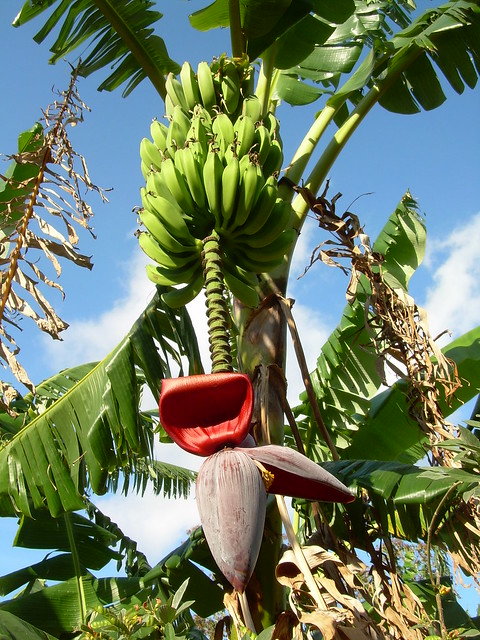



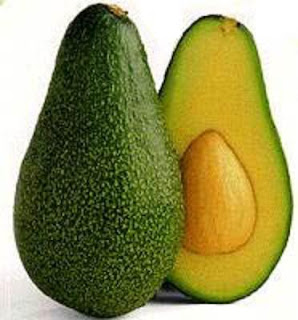









2 comments:
Wonderful post...really informative and enjoyed reading...
Thank you for the nice comments.
Post a Comment